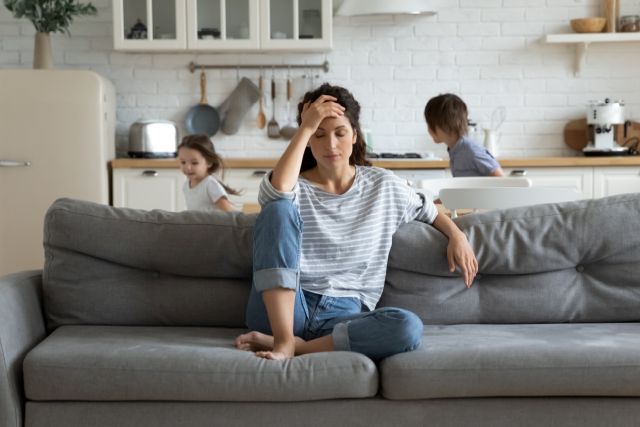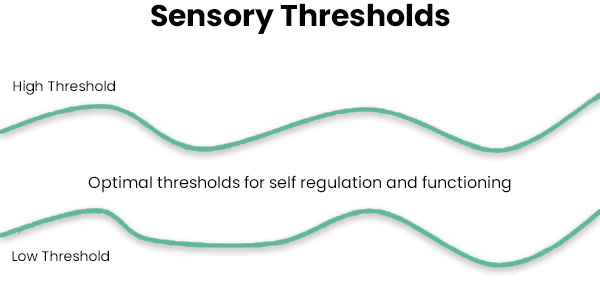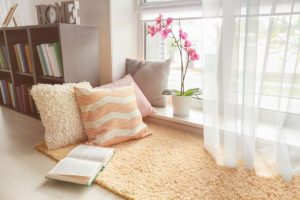Sensory Processing
Create a Sensory Refuge (for adults living with SPD!) Within Your Home During Quarantine
What do you think of the idea of creating a “Sensory Refuge” (for the adults living with SPD…) within your home during quarantine?
You know, I work almost exclusively with children who face sensory integration challenges.
However, I am finding it more and more important in these unusual times to take some time to shine the light on sensory overload meltdown in adults as well. I mean, sure, adults have our preferences and sensitivities.
Some love a quiet hour with a book, and they find their balance by spending time alone and quiet. Others love the hustle and bustle of people and loud music – they recharge with it.
They get energy and motivation from it. Some of you may cope well in an open-plan office, while others prefer the quiet behind a closed door. And when your world is turned suddenly upside down, everyone suffers a bit.
Perhaps your children and spouse are suddenly home with you 24/7 and you don’t have that time to yourself to re-center. Perhaps you’re home alone without the opportunity to feed off of the energy of an adrenaline-filled workday or weekend on the town.
A. What is Sensory Processing and Sensory Processing Disorder?
Imagine your senses being more than just “the 5 senses”. And, instead imagine all of the sensations from the environment and our own body that we perceive.
This includes:
- Sight
- Hearing
- Taste
- Smell
- Touch
- Movement
- Body Positions
- Internal body process awareness
So, let’s say that your sense of hearing informs you that an action scene on TV is too loud. Normally, you can easily get up and turn the volume down to make yourself more comfortable.
Or perhaps the sun is too bright, making it hard to see around you. Or, to pay attention to what someone is saying because you’re distracted by the brightness. So, you put on sunglasses and resume normal conversation.
There are many forms of Sensory Processing Disorders. Each one can affect each person differently. In the above examples, it could go like this. One person with SPD may have an overwhelmed auditory reaction from something much quieter or less obvious than the noisy TV.
Another adult with SPD may feel the same sensation from the brightness that causes her to squint and cover her eyes. However, she doesn’t recognize the cause or how to regain stability. She may not be able to carry on the conversation, or even keep walking.
Her “fight or flight” mode may kick in, and she is seemingly shut down. This could result in her standing in the middle of the sidewalk, squeezing her head with her hands. That’s how sensory processing disorder can affect a person’s day to day life.
Sensory processing disorder symptoms in adults can have sensitivities to specific sensations.
Some adults are more sensitive to specific sensations than others. This can be so much so that the sensitivity interferes with their daily life. I have met adults that cannot handle the sounds in a quiet exam room.
The sound of pens on paper, of people breathing and of the movement of others in the room. For an adult with SPD, these sensations are too much for them.
The quiet sounds in an otherwise silent room interfere with their concentration and focused attention.
I know adults with extreme sensitivity to others chewing food. Have you ever been in a movie theater during a quiet moment, and the sound of the person behind you eating popcorn drove you to the brink of screaming? Other adults are extremely sensitive to smells.
So, they refuse to spend time in certain public places because of the smells alone. Adults can also have sensory issues with clothing. They might be sensitive to textures in clothes and would avoid these textures when buying clothes.
Or, they’ll usually take labels and tags off before wearing a newly purchased item of clothing.sensory processing disorder symptoms in adults
B. Usually, adults have choices regarding activities
Many adults with sensory processing disorder challenges cope well in everyday life. Being an adult, they largely have choices. What does sensory overload feel like?. Firstly, they can choose their work environment and the activities they attend.
Furthermore, they usually have a choice about the tasks they are involved in. As in the example with the loud TV, an adult can usually modify their situation easily to remedy their sensory overload.
(Children do not have these choices; therefore symptoms of SPD are easier to identify during childhood.)Yet, the effect of SPD that cause struggle for an adult with SPD are the same as those facing the challenges as a child.

C. Quarantine has changed that
These days, so many adults are struggling through an environment they normally would be able to escape at some point. You might normally take a 15-minute break every two hours while working at an office.
However at home, it may be a different story! Chances are, there’s rarely a good opportunity to slip away and be alone in the quiet of a break room. Perhaps you had previously been in the routine of heading to the gym every afternoon.
At the gym you can have that intense workout that satisfies a sensory need to hit, pound, run, or climb. But now the gyms are closed due to the COVID-19 pandemic.
So, you aren’t getting the sensory input and adrenaline release your body craves. Maybe you have noisy family members making a constant din throughout the day. And so, your auditory system is in constant overwhelm.
Maybe you have a preschooler constantly clutching at your arms and legs. By 4 pm every day you might feel your touch sensitivity getting put to the test. And, what if you’re on the other end of the sensory spectrum and you’re stuck home alone?
Isolated alone in the quiet, without a chance to satisfy your sensory-seeking activities, you’re suffering along with the rest. If you are an adult with SPD, you will surely relate. with adult sensory issues.

D. Spd in adults, am I one who has it?
I’m most certainly not implying that any overwhelmed parent who is struggling right now is an adult with SPD!
Not every parent who finds him or herself reaching for an extra glass of wine in the evenings during this quarantine is subject to sensory processing disorder! I don’t encourage blaming every moment of overwhelm on sensory challenges.
What I am discussing is the reality that there is a population of adults who are in very unusual circumstances right now. This is because they can’t regulate their environment as they normally would. So, their underlying sensory processing issues might be coming to the surface for the first time in their lives.
I’m basing this conversation on my experiences over the past 40 years working with parents of children with SPD and the connections we made during their child’s evaluation and intervention process.
3 examples:
1. Parents often relate to SPD when their child has been evaluated.
When I explain SPD to parents after assessing a child, it stirs memories. Often one of the parents will indicate that they experience the same sensitivities as the child.
They are often relieved to hear why they have different reactions from others. And they’re also relieved to learn that it can be addressed with strategies and some therapy interventions to help them.
It had never previously occurred to them that they could be an adult with SPD.
2. Some anxiety symptoms might actually be SPD.
Many adults with SPD present with other symptoms such as anxiety. SPD is the ability to filter the sensations in the environment. If the filtering is inadequate, there are too many sensations to process.
The person has a low threshold for tolerating too many sensations at once. So, the result comes out as anxiety and feelings of being overwhelmed. That person will likely avoid certain activities that cause him/her anxiety.
Yet, they won’t really have an understanding what the anxiety is about.

There’s a counter side to SPD, too. A person might also have a high threshold for sensations. That means that without enough bustle and activity going on in the background, a person can have difficulty focusing or being mindful.
He or she might be called a daydreamer. They may be lethargic and have low energy levels. They could feel like they’re fighting attention span problems.
3. Adults living with SPD will benefit from strategies.
As adults, we like to feel like we understand everything. We like to have a plan of attack. How often have you heard someone say they felt relief just at hearing a diagnosis, after years of searching for answers?
We take tremendous relief in putting a name to our worry. And, having a list of actions to work toward conquering a goal is a relief. An adult with SPD can benefit hugely from intervention and strategies to assist them in everyday life.
These will reduce anxiety and boost self-esteem. Oftentimes, relationships with family members benefit. When taking control over anxiety and the unknown that play into adult sensitivities, everyone wins.
E. What can sensory sensitive adults do for relief?
When working with an adult with SPD, occupational therapists recommend a 4-pronged approach:
- Support
- Sensory integration therapy
- Create Sensory Lifestyle
- Environmental modifications
Some specific actions to take in each of those four areas include the following:
1. Work with an occupational therapist for support and further understanding.
A therapist experienced in sensory integration techniques can help you create a family sensory profile. This profile will enable them to give you specific strategies to navigate your SPD.
Happily, the strategies are usually quite easy. A sensory profile of each member of the family is valuable to identify differences among family members. Occupational therapy for spd adults usually gives family members better insight into one another.
And it makes it easier to understand the preferences, dislikes and behaviour of fellow family members. Differences and irritations among family members are often dissolved! Intolerances can disappear once they understand the reason for specific behaviours in other family members.
If you’d like to set up a virtual consultation with myself or any of our other providers, we’d love to talk to you. Just head to Coordikids Consultation to view the process.
2. Have regular movement breaks that involves targeted exercises.
Some good physical activity before, sporadically during, and right after overwhelming situations have been proven helpful for people to adapt, recuperate from, or prevent anxiety attacks.
Certain physical movements that provide feedback to the vestibular and proprioceptive systems are particularly beneficial. That’s why my team created the CoordiKids courses in the first place.
We created the CoordiKids courses to offer children a daily dose of targeted exercise for their sensory system. Try doing the Classroom Course as a family.
Right now, we’re offering access to that program for free during the pandemic closures.
So, it’s a great time to see if these types of movement breaks can help your daily anxiety levels and emotional regulation. Start your free trail today.
3. Practice self-regulation techniques in advance. Detect and redirect.
When you start to feel those first sensations of anxiety in yourself, take a moment to “play detective”.
What is going on around you that’s triggering the anxiety? Is it a loud noise you hear in the distance that is growing louder? Is there a lot of visual movement around the periphery of your work-from-home space?
Redirect your mind and body by shifting your position (i.e. move to your sensory refuge for 10 minutes).
Or, take some deep breaths. Mediate for 10 minutes. Get up and do some physical activity.
4. Modify your environment as you can.
Put up visual barriers if needed. Also, wear sound-cancelling headphones while you work from home. Use a soothing screen saver in the background.
Adjust the lighting. Sometimes simply switching from fluorescent overhead lighting to a softer bulb in a lamp can provide tremendous relief.
5. Create three specific spaces in your home.
Adult with SPD should create a specific space in your home to work, another specific space to do schoolwork with children, and a third space as a sensory refuge. Even if the spaces are as minimal as a different corner of the same room.
Or, turning chairs to face in different directions. It’s a technique that people have used for years to create different atmospheres to help their mind focus on the tasks at hand. I highly recommend everyone tries this during the quarantine period!

F. How to Create a Sensory Refuge in Your Home to Address Sensory Needs During Quarantine
Have you seen how popular play tents are in children’s room décor lately?
There’s a reason. They’re a perfect “nook” for your child to feel secure within. And I bet your dog or cat has a crate or house of their own! Somewhere for them to retreat to when they’re tired of the kids pulling on their tail.
Do you have a nook of your own right now? If not, it’s the perfect time to create one, no matter how small. Creating a physical space within your home as a sensory refuge is more important now than ever.
During Quarantine, we’re doing EVERYTHING in our home:
- schooling our children,
- office work,
- housework,
- playtime with family,
- arguing with family,
- feeling the stress of the world news.
Our home is no longer the safe or fun space we retire to at the end of a long day at work. So, we must create a small refuge within our space. A nook of your own.
Your nook might be a single comfortable chair facing a corner of a room. Or, a pile of throw pillows in front of a window. It might even be your bathroom, where you can shut a door and turn off the lights.
No matter how small or seemingly insignificant your refuge may be, here are some tips for ensuring you get the sensory relief you need:
-
Set a specific time of day, every day, to spend 15 minutes in your sensory refuge.
Consider using this time to transition from “work” mode to “homeschool teacher” mode. Or, to “relaxed mom before dinner” mode. Is there is a pattern to your stress build-up every day? If so, anticipate it and plug in some sensory relief time just before that cycle starts.
-
Simulate “quiet”.
Use a sound machine, a fan, or a radio tuned between stations for steady, white noise. Or, buy yourself some sound-cancelling headphones to create a way to sit in the quiet for 15 minutes.
-
Try low light and no visual distractions.
The lighting in your workspace is critical, isn’t it? Too little and you can’t see your work. Too bright and you have a headache by the end of the day. Make sure your sensory refuge has ambient lighting to relieve your eyes. Candles, twinkle lights, or a lamp on a dimmer will hit the spot.
-
Use tactile relief.
Use soft pillows and plush, velvet or fleece blankets. There’s a reason trendy interior designs love layering fleece, fur, wool, and knit blankets. Not only do they add warmth in cold months, but a variety of texture is great for tactile stimulation and sensory exploration. But don’t forget the opposite side of the sensory spectrum. Sometimes lying flat on your back on a cold, hard marble floor might be the release your nerves need.
-
Enjoy aromatherapy.
It’s time to call on that friend of yours who sells essential oils and wax diffusers! Pick a scent that’s not already used in other parts of your house.
-
Try oral input.
A crunchy snack, sucking juice through a straw, or even chewing gum can offer relief for adults who need oral input and pressure. Some adults say they love to create contrasting flavour and texture snacks. Examples might be a hot chocolate followed by cold blueberries. Or a crunchy granola followed by smooth yogurt.
Does any of the information in the article speaks to you personally? If so, you may want to speak to an experienced professional in this field, so please reach out to me for a chat.
You can schedule a time that works for both of us using my scheduler. It’s on CoordiKids Consultation and select the free 15-minute consultation option so we can get to know one another.
And do remember the free trail to our CoordiKids movement breaks programs: Classroom Course